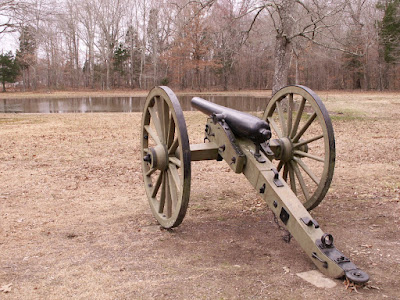
The battle began on the morning of April 6 with a Confederate attack led by General Johnston’s army. A night of quietly waiting just a few miles to the south of the Union camp paid off as the Union encampment was nearly taken by surprise. Union troops fell back quickly in the early morning hours as they struggled to form cohesive lines of battle. A few rallies, combined with a somewhat uncoordinated confederate attack eventually slowed the advance enough for the Union troops to establish defensive lines around what was known as the Hornet’s nest.
I had the chance to visit this battlefield a few weeks back. It was a dull, and appropriately somber day to visit a battlefield, but still pleasant enough to spend some time walking along the sunken road in front of the hornet’s nest.
Click Here [+/-]
 I began at Ruggles’ batteries, on the western side of the Confederate lines. From here, the Confederate artillery bombarded the Union lines from across
I began at Ruggles’ batteries, on the western side of the Confederate lines. From here, the Confederate artillery bombarded the Union lines from across 
Crossing the field I began to walk down the sunken road, which marks the Union line for most of the day of April 6. This area received massive amounts of fire throughout the day, only falling into Confederate hands late in the afternoon.

Standing here, it's amazing to think about the amount of fire taken by the soldiers in this position, and perhaps it is equally amazing to think of Confederate troops staging attacks across this open field.
 I continued on to the east, following the Union line. Eventually it proceeds into more wooded areas.
I continued on to the east, following the Union line. Eventually it proceeds into more wooded areas. 
In these areas a few seemingly abandoned monuments rise up along the path, marking the positions held throughout the day.

Eventually the Union line emerges into an open area where an orchard once grew. Soldiers reportedly said that the bullets clipped so many blossoms from the trees that it looked like falling snow. The orchard has recently been replanted, and in another decade it may start to look much more like it did during the battle.
 Only a little further north is the site of
Only a little further north is the site of  It’s a serene scene now, but in 1962 this would have been a chaotic place with wounded soldiers and abandoned equipment all around the pond. It’s hard to believe this was once such a dismal place.
It’s a serene scene now, but in 1962 this would have been a chaotic place with wounded soldiers and abandoned equipment all around the pond. It’s hard to believe this was once such a dismal place. On this end of the line, the Union troops could have easily lost the battle. Had Confederate troops exploited a collapse in the Union lines, they could have forced them away from Pittsburg Landing, which could have ultimately led to a Confederate victory. Confusion in the Confederate ranks kept them from exploiting the Union weaknesses, due at least in part to the loss of General Johnston who was wounded in battle, and bled out, not knowing the seriousness of his wound.
On this end of the line, the Union troops could have easily lost the battle. Had Confederate troops exploited a collapse in the Union lines, they could have forced them away from Pittsburg Landing, which could have ultimately led to a Confederate victory. Confusion in the Confederate ranks kept them from exploiting the Union weaknesses, due at least in part to the loss of General Johnston who was wounded in battle, and bled out, not knowing the seriousness of his wound. Eventually the Union lines fell back, forming a line around Pittsburg Landing. In the evening hours, reinforcements were ferried across the river to join Grant’s troops. Come the morning hours the Union counterattack began and Confederate general Beauregard suddenly found himself outnumbered and outgunned. A hard day of battle followed in which the Confederate forces were pushed back South, eventually retreating toward Corinth, leaving only a field hospital and a rear guard.
Eventually the Union lines fell back, forming a line around Pittsburg Landing. In the evening hours, reinforcements were ferried across the river to join Grant’s troops. Come the morning hours the Union counterattack began and Confederate general Beauregard suddenly found himself outnumbered and outgunned. A hard day of battle followed in which the Confederate forces were pushed back South, eventually retreating toward Corinth, leaving only a field hospital and a rear guard. It was a horrifically bloody battle that would grab the attention of the nation. It was reported as the battle of


No comments:
Post a Comment